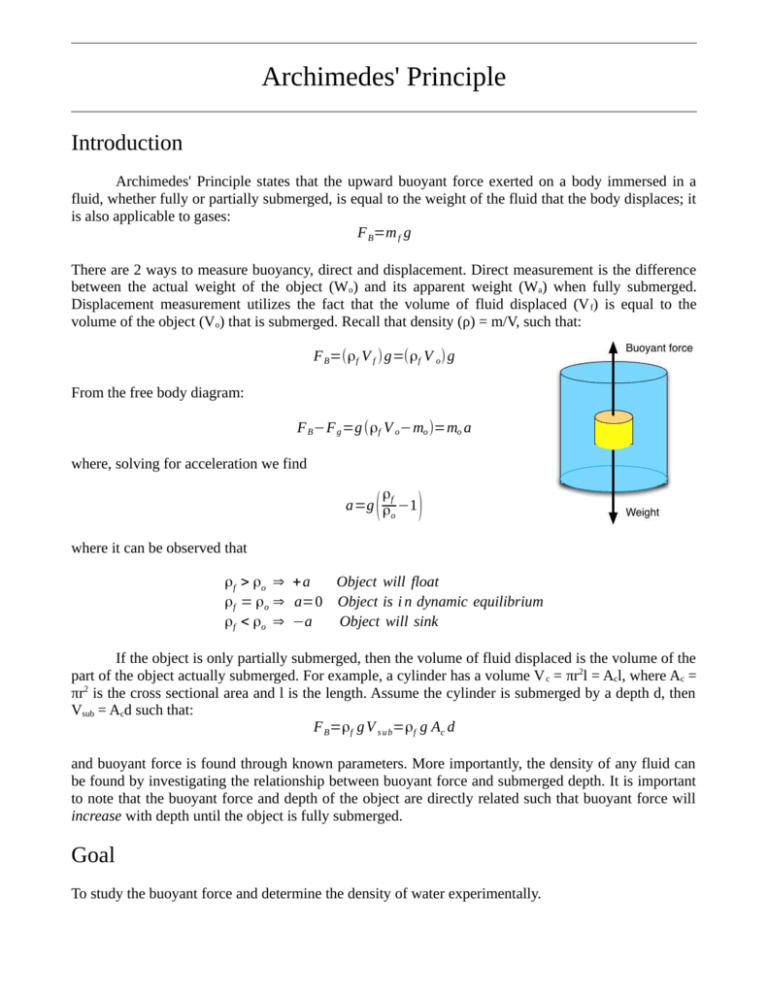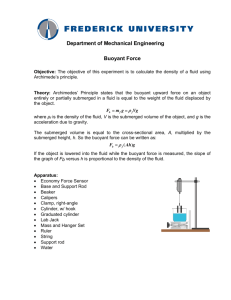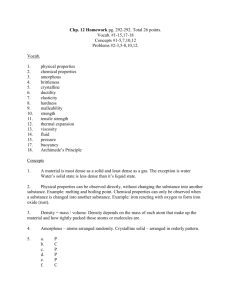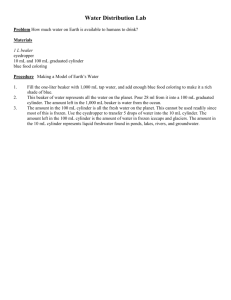Archimedes' Principle
advertisement

Archimedes' Principle Introduction Archimedes' Principle states that the upward buoyant force exerted on a body immersed in a fluid, whether fully or partially submerged, is equal to the weight of the fluid that the body displaces; it is also applicable to gases: F B=m f g There are 2 ways to measure buoyancy, direct and displacement. Direct measurement is the difference between the actual weight of the object (Wo) and its apparent weight (Wa) when fully submerged. Displacement measurement utilizes the fact that the volume of fluid displaced (V f) is equal to the volume of the object (Vo) that is submerged. Recall that density (ρ) = m/V, such that: F B=(ρf V f ) g=(ρf V o)g From the free body diagram: F B−F g =g (ρf V o−mo )=mo a where, solving for acceleration we find ρ a=g ρf −1 o ( ) where it can be observed that ρf > ρo ⇒ +a Object will float ρf = ρo ⇒ a=0 Object is i n dynamic equilibrium ρf < ρo ⇒ −a Object will sink If the object is only partially submerged, then the volume of fluid displaced is the volume of the part of the object actually submerged. For example, a cylinder has a volume V c = πr2l = Acl, where Ac = πr2 is the cross sectional area and l is the length. Assume the cylinder is submerged by a depth d, then Vsub = Acd such that: F B=ρf g V s u b=ρf g Ac d and buoyant force is found through known parameters. More importantly, the density of any fluid can be found by investigating the relationship between buoyant force and submerged depth. It is important to note that the buoyant force and depth of the object are directly related such that buoyant force will increase with depth until the object is fully submerged. Goal To study the buoyant force and determine the density of water experimentally. Equipment Force Sensor Beaker Base and Support Rod Lab Jack Brass and Aluminum cylinders String Lab Notes In this lab, you will determine the density of water experimentally by studying the relationship between buoyant force and submerged depth of 2 cylindrical objects, one brass and one aluminum. A cylinder will be connected by a string to the force sensor and will hover over a beaker of water on a lab jack. The lab jack will slowly be raised, submerging the cylinder in 1cm stages such that the buoyant force can be obtained at each depth. However, the force sensor measures all forces exerted upon it and thus it will not only measure the buoyant force, but also gravitational force. To remove the gravitational force, the sensor must be tared before the object is submerged. After determining the buoyant force at each depth, a graph of Force vs Depth can be created. Using the buoyant force equation from the previous page, the slope of this graph is related to the density of water by: slope= FB =ρw g A c d Thus the density of water is found by ρw = slope slope = g Ac g π r 2 Setup Cylinder 1. Fill a beaker with enough water that the cylinder can be fully submerged and place on the lab jack. Ensure the jack is fully compressed. 2. Attach a cylinder by string to the force sensor and hang it above the beaker and jack. 3. Loosen the thumbscrew that holds the rod the force sensor is attached to, and lower the force sensor so that the bottom of the cylinder just touches the water in the beaker. Re-tighten the thumbscrew. 4. Tare the force sensor. Computer 1. Log in, open Capstone, then click 'Hardware Setup': 2. Click the Analog Channel A button on the interface picture and add 'Force Sensor'. Set the frequency to 20 hz. 3. Click the 'Data Summary' tab: (a) Click 'Force (N)' to highlight, then click the Gear icon to the right of it. (b) Click 'Numerical Format' and change the 'Number of Decimal Places' to 3, then click 'Ok'. 4. Click the 'Table & Graph” icon. (a) Table i. In the x-coordinate column, click 'Select Measurement' ii. Click 'Create New' then 'User-Entered Data' iii. Label the highlighted term 'User Data' as 'Depth' iv. Hit Enter, then label the highlighted term 'Units' as 'm' for meters. v. Add depth data, starting from zero and incrementing by 1cm for each row, ie, 0, 0.01, 0.02, etc. vi. In the y-coordinate column, click 'Select Measurement' vii. Click 'Force' (b) Graph i. For the y-axis, click 'Select Measurement' ii. Click 'Force', this will provide a Force vs Time graph 5. At the bottom of the screen, change to Helpful Hints: 1. By starting with the bottom of the cylinder just touching the water, the act of raising the lab jack by 1 cm will submerge the cylinder by 1 cm. 2. Once you begin recording data, you will let the timer run until the cylinder is completely submerged. Do NOT stop recording at any stage of submersion unless you need to start over. 3. The accepted density of water is 1000 kg/m3. Procedure Objective 1: Brass Cylinder 1. Measure the cross sectional area of the cylinder and record in Table 1. 2. Click 'Preview', the timer will start. 3. Observe the F vs t graph and ensure the Force is zero. If not, tare the force sensor again. If the force sensor will not tare, contact your TA. 4. Press 'Keep Sample'. This will provide your first data point in the table. 5. On the graph's x-axis, click the label 'Time' and change to 'Depth'. You will see this first data point. 6. Raise the lab jack 1cm (which submerges the cylinder 1cm). 7. Wait for the cylinder to stabilize, then click 'Keep Sample'. 8. Repeat # 5-6 until the cylinder is completely submerged. 9. Click 'Stop'. 10. Click 'Fit' and select 'Linear'. Record the slope in Table 1. 11. From this slope, calculate the density of water. 12. Calculate the %Error between this and the accepted density of water. 13. Export data to excel to re-graph for your lab report. Objective 2: Aluminum Cylinder 14. 15. 16. Measure the cross sectional area of the cylinder and record in Table 2. Repeat setup and procedure as for brass cylinder. Don't forget to re-tare. Export data to excel to re-graph for your lab report. Data Table 1: Brass Cylinder Item Value Cross Sectional Area of Cylinder (πr2) Slope of Force vs Depth Graph Calculated Density of Water %Error Table 2: Aluminum Cylinder Item Cross Sectional Area of Cylinder (πr2) Slope of Force vs Depth Graph Calculated Density of Water %Error Sample Calculations: Value Analysis 1. Explain possible sources of error that would account for the difference between experimental and accepted density of water. 2. Compare the experimental density of water from the brass and aluminum cylinder using percent difference. 3. Explain possible sources of error that would account for the difference between experimental densities. 4. Graph, by hand, your Force vs Depth data for both the brass and aluminum cylinder. (a) Fit the data and calculate the slope. (b) Calculate the density of water from the slope. (c) How does this value differ from the slope in the tables? Calculate %Difference. (d) If the values are different, explain why. 5. Explain why it is easier to float in the ocean than in a swimming pool.







